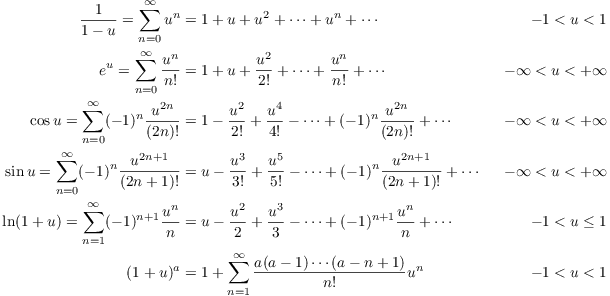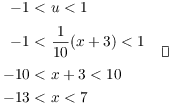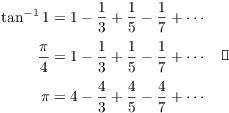The Taylor series for ![]() at
at ![]() is
is
![]()
(By convention, ![]() .) When
.) When ![]() , the series is called a Maclaurin
series.
, the series is called a Maclaurin
series.
You can construct the series on the right provided that f is
infinitely differentiable on an interval containing c. You already
know how to determine the interval of convergence of the series.
However, the fact that the series converges at x does not imply that
the series converges to ![]() .
.
As an example, consider the function
![]()
It is infinitely differentiable everywhere. In particular, all the derivatives of f at 0 vanish, and the Maclaurin series for f is identically 0.
Hence, the Maclaurin series for f converges for all x, but only
converges to ![]() at
at ![]() .
.
The following result ([1], page 418) gives a sufficient condition for the Taylor series of a function to converge to the function:
Theorem. Let ![]() be infinitely
differentiable on
be infinitely
differentiable on ![]() , and let
, and let ![]() . Suppose there is a constant M such that
. Suppose there is a constant M such that ![]() for all
for all ![]() , and for all x in
, and for all x in
![]() , where N is a neighborhood of c. Then for
all
, where N is a neighborhood of c. Then for
all ![]() ,
,
![]()
In other words, under reasonable conditions:
1. You can construct a Taylor series by computing the derivatives of f.
2. The series will converge to f on an interval around the expansion point. (You can find the interval of convergence as usual.)
It's tedious to have to compute lots of derivatives, and in many cases you can derive a series from another known series. Here are the series expansions for several important functions:

Example. Find the Taylor series for ![]() at
at ![]() . What is its interval of
convergence?
. What is its interval of
convergence?
I want things to come out in powers of ![]() , so I'll write the
function in terms of
, so I'll write the
function in terms of ![]() :
:

I'll use the series for ![]() . To do
this, I need
. To do
this, I need ![]() on the bottom. I make a "1" by
factoring 5 out of the terms on the bottom, then I make a
"-" by writing the "+" as "
on the bottom. I make a "1" by
factoring 5 out of the terms on the bottom, then I make a
"-" by writing the "+" as "![]() ":
":

Let ![]() in the series for
in the series for ![]() . Then
. Then

Hence,
![]()
The u-series converges for ![]() , so the x-series
converges for
, so the x-series
converges for ![]() , or
, or ![]() .
.![]()
Example. Find the Taylor series for ![]() at
at ![]() . What is its interval of
convergence?
. What is its interval of
convergence?
Since I'm expanding at ![]() , I need powers of
, I need powers of ![]() :
:

I let ![]() in the series for
in the series for ![]() :
:

In summation form, this is ![]() .
.
Find the interval of convergence:

Example. Find the Taylor series at ![]() for
for ![]() .
.
I need powers of ![]() .
.
![]()
To get this, I let ![]() in the series for
in the series for ![]() .
.
For the interval of convergence:

Example. Find the Taylor series for ![]() at
at ![]() .
.
I need powers of ![]() , so
, so
![]()
Next, I'll use the angle addition formula for sine:
![]()
I set ![]() and
and ![]() . Since
. Since
![]() and
and ![]() ,
I get
,
I get
![]()
Example. Find the Taylor series for ![]() at
at ![]() . What is its interval of
convergence?
. What is its interval of
convergence?
Use
![]()
I'm expanding at ![]() , so I want the result to come out
in powers of
, so I want the result to come out
in powers of ![]() . This is easy --- just set
. This is easy --- just set ![]() :
:
![]()
The u-series converges for ![]() , so the x-series
converges for
, so the x-series
converges for ![]() , or
, or ![]() .
.![]()
Example. The quantity ![]() occurs in special relativity. (v is the velocity of an object, and c
is the speed of light.) Approximate
occurs in special relativity. (v is the velocity of an object, and c
is the speed of light.) Approximate ![]() using the first two nonzero terms of the binomial
series.
using the first two nonzero terms of the binomial
series.
![]()
So for ![]() ,
,
![]()
Take ![]() :
:
![]()
The approximation is good as long as v is small compared to c.![]()
Example. Find the Taylor series for ![]() at
at ![]() .
.
Since I'm expanding at ![]() , the answer must come out in
terms of powers of
, the answer must come out in
terms of powers of ![]() .
.
Start with the function you're trying to expand. To get ![]() 's in the answer, write the given function in terms
of
's in the answer, write the given function in terms
of ![]() :
:
![]()
(Notice that the work has to be legal algebra.)
I'll break up the fraction and do the pieces separately.
![]()
I want to "match" each piece against the standard series
![]() . Here's the first piece:
. Here's the first piece:
![]()
Expand ![]() by setting
by setting ![]() in
in ![]() :
:
![]()
Here's the second piece:
![$$\dfrac{1}{1 + (x + 1)} = \dfrac{1}{1 - [-(x + 1)]} = 1 - (x + 1) + (x + 1)^2 - (x + 1)^3 + \cdots.$$ Put the two pieces together:](taylor-series93.png)
![]()
![]()
![]()
That is,
![]()
Example. What is the Maclaurin series for ![]() ? What is the Taylor series for
? What is the Taylor series for ![]() at
at ![]() ?
?
The Maclaurin series for a polynomial is the polynomial: ![]() .
.
To obtain the Taylor expansion at ![]() , write the
function in terms of
, write the
function in terms of ![]() :
:
![]()
Example. Find ![]() for
for ![]() .
.
The series for ![]() at
at ![]() is
is

![]()
The ![]() degree term is
degree term is ![]() . On the other hand, Taylor's formula says
that the
. On the other hand, Taylor's formula says
that the ![]() degree term is
degree term is ![]() . Equating the coefficients, I get
. Equating the coefficients, I get

While you can often use known series to find Taylor series, it's sometimes necessary to find a series using Taylor's formula. (In fact, that's where the "known series" come from.)
Example. Find the first four nonzero terms and
the general term of the Taylor series for ![]() at
at ![]() and at
and at ![]() by computing the derivatives of f.
by computing the derivatives of f.
![]()
For ![]() ,
, ![]() for all n. The Taylor
series at
for all n. The Taylor
series at ![]() is
is
![]()
For ![]() ,
, ![]() for all n. The Taylor
series at
for all n. The Taylor
series at ![]() is
is
![]()
If you truncate the series expanded at c after the ![]() -degree term, what's left is the
-degree term, what's left is the ![]() - degree Taylor polynomial
- degree Taylor polynomial ![]() . For example, the third degree polynomial of
. For example, the third degree polynomial of ![]() at
at ![]() is
is
![]()
Note that the "n" here refers to the largest power
of x, not the number of terms. For example, the Taylor series
for ![]() at
at ![]() is
is
![]()
The ![]() degree Taylor polynomial and the
degree Taylor polynomial and the ![]() degree Taylor polynomial are equal:
degree Taylor polynomial are equal:
![]()
Example. Find the ![]() degree Taylor polynomial for
degree Taylor polynomial for ![]() at
at ![]() .
.
![]()
Thus,
![]()
The ![]() degree Taylor polynomial is
degree Taylor polynomial is
![]()
Example. Suppose
![]()
Use the ![]() degree Taylor polynomial for f at
degree Taylor polynomial for f at ![]() to approximate
to approximate ![]() .
.
I have
![]()
Plug ![]() in:
in:
![]()
It's also possible to construct power series by integrating or differentiating other power series. A power series may be integrated or differentiated term-by-term in the interior of its interval of convergence. (You will need to check convergence at the endpoints separately.)
Example. (a) Find the Taylor series at ![]() for
for ![]() .
.
(b) Find the Taylor series at ![]() for
for ![]() .
.
(a)
![]()
![]()
(b) Notice that
![]()
Hence,
![]()
![]()
Example. (a) Find the Taylor series at ![]() for
for ![]() .
.
(b) Use the series in (a) to find the series for ![]() expanded at
expanded at ![]() .
.
(a) Put ![]() in the series for
in the series for ![]() to obtain
to obtain
![]()
It converges for ![]() .
.![]()
(b) Integrate the series in (a) from 0 to u:
![]()
This series will converge for ![]() . The left side
blows up at
. The left side
blows up at ![]() . On the other hand, if
. On the other hand, if ![]() ,
,
![]()
The right side does converges (by the Alternating Series
Test), so the ![]() series converges for
series converges for ![]() .
.![]()
Example. Find the Taylor series for ![]() at
at ![]() .
.
First, note that
![]()
I integrated from 2 to x because I want the expansion at ![]() .
.
Now find the series at ![]() for
for ![]() :
:

Plug this series back into the integral and integrate term-by-term:
![]()
![]()
Example. (a) Construct the Taylor series at
![]() for
for ![]() .
.
(b) Use the series in (a) to construct the Taylor series at ![]() for
for ![]() .
.
(c) Use the series in (b) to obtain a series for ![]() .
.
(a) I need powers of t, so
![]()
(b) Note that
![]()
Therefore,
![]()
![]()
(c) Plug ![]() into the series in (b), using the fact that
into the series in (b), using the fact that
![]() :
:

Think of a Taylor series as a "replacement" for its function. For example, you can often use a Taylor series to compute a limit or an integral by replacing a function with its series.
Example. (a) Find the first 4 nonzero terms of
the Taylor series at ![]() for
for ![]() .
.
(b) Use the series in (a) to guess the value of ![]() .
.
(a) Let ![]() in the series for
in the series for ![]() :
:
![]()
(b) Plug the series from (a) into the limit:
![]()
Example. (a) Construct the Taylor series at
![]() for
for ![]() . (Write out at least
the first 4 nonzero terms.)
. (Write out at least
the first 4 nonzero terms.)
(b) Use the first 3 terms of the series in (a) to approximate ![]() .
.
(c) Use the Alternating Series error estimate to estimate the error in (b).
(a) I set ![]() in the series for
in the series for ![]() :
:
![]()
Multiply by ![]() :
:
![]()
(b)
![]()
(c) The Alternating Series error estimate says that the error is less than the next term. So I take the next term in the series in (a) and integrate:
![]()
The error in the estimate in (b) is no greater than ![]() .
.![]()
[1] Tom M. Apostol, Mathematical Analysis. Reading, Massachusetts: Addision-Wesley Publishing Company, Inc., 1957.
Copyright 2020 by Bruce Ikenaga